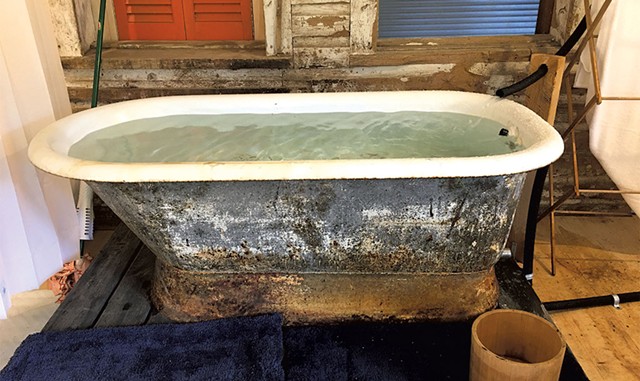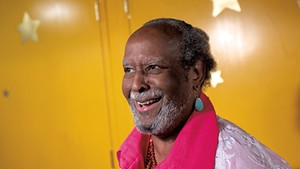
- Pamela Polston ©️ Seven Days
- "Cold Plunge"
The Museum of Everyday Life in Glover is a uniquely Vermonty marvel. It mounts just a single exhibit each year, but for the whole year. It's free, though donations are welcome. It's unlocked and unstaffed; visitors are instructed to turn on the lights when they arrive and, if no one else is there, shut them off when they leave. The building, a big white time-worn barn, is unheated and uncooled — dress accordingly. The place has a distinct "cheap art" aesthetic on par with the Bread and Puppet Museum up the road. That's no coincidence; founder Clare Dolan is a Bread and Puppet Theater veteran.
As its name plainly states, this repository considers the quotidian — stuff that fancier museums might not deem, well, museum-worthy. Previous exhibitions have presented thoughtful and entertaining surveys of the pencil, scissors, rope, bells and whistles, notes and lists, and — most improbably — dust. (Then again, what is more "everyday" than dust?) All of the artifacts are donated and found.
This year, the museum invites visitors to contemplate bathing. Titled "Coming Clean," the new collection of objects "takes a look at how and why we humans wash ourselves," introductory text explains. Throughout history and across cultures, we have "developed an enormous variety of strategies in response to the persistent impulse to make ourselves 'clean.'"
That big white barn is actually filled with truncated versions of its previous exhibitions — now comprising a permanent collection. So, Dolan opened up an adjacent former milking parlor for the installation of "Coming Clean." The room itself seems freshly scrubbed, boasting a new pine floor and white-painted walls. Once a home for lactating bovines, the space is a country cousin to the standard white-cube urban gallery. But the exhibition actually begins outside.
In a grassy courtyard, visitors can choose to take a solar-powered shower or rinse their hands in a small spring-fed pool. The latter is a Northeast Kingdom version of tsukubai, which are "wash basins placed at the gates of holy places for ritual cleansing" in Japan, explains the signage. Another outdoor installation is a makeshift shrine: "holy water" in a chipped enamel basin beneath a picture of Bernadette, whose 1858 sighting of the Virgin Mary turned a grotto in Lourdes, France, into a pilgrimage site for believers, who still visit to this day.
Entering the gallery space, the first impression is auditory: It's the sound of water — not sacramental, but the running-bathtub sort. Sure enough, at the back of the room a rusty old iron tub is filled almost to the brim with water that trickles in from a hose. (A drain hole prevents the tub from overflowing.) And that water is frigid. Here visitors are invited to take a "Cold Plunge." Hardy types who dip into Lake Champlain in the winter might go for this challenge — a changing area is nearby, enclosed by a shower curtain. The rest of us might briefly stick in a finger or two. Towels are provided.
Many of the entries for this theme are on point: myriad scrubbers, sponges and exfoliating items; various soaps and cleansers; old porcelain faucet handles; a bidet; a couple of foot-soaking basins (visitors are invited to indulge in the electric one); vintage posters illustrating proper handwashing; a rubber duckie ("You make bath time lots of fun!").
The museum's exhibitions always attract some obsessive collectors who must be thrilled to find kindred spirits. For "Coming Clean," a donor named Jack Bossom sent in a few dozen moist towelettes, arranged in groups and framed under glass. They make up just a fraction of the unopened packets that he began to amass 20 years ago — most from air travel. "Now I have what I believe is the largest collection in the world, outside of the companies that make them," he wrote with understandable pride. His towelettes have a charming variety of names: Wash-Up, Tote Towel, Clean-Quick, Jiffy Towel, Wet-Nap, Twinks and, best of all, Wash Away Your Sins.
Other displays are unexpected, such as the photos of a gay male bathhouse in New York City and an audio recording (heard through headphones) of Bette Midler singing at one of them in 1971. "Accompanied on the piano by the young Barry Manilow," reads a text, she "developed her stage persona and honed her chops in front of audiences of men in towels sitting poolside."
One especially remarkable item is a grainy black-and-white film of ritual cleansing. The date and religious tradition are not specified, but wall text notes that such practices are found in Christian, Islamic and Jewish faiths. "Some scholars theorize that our mysterious attachment to concepts of spiritual purity and impurity might have evolved from impulses that initially promoted hygiene behaviors that kept us safe from life-threatening pathogens," reads the text.
A famous "bathing" image in the exhibition was shot in 1969 but still resonates. On the children's show "Mister Rogers' Neighborhood," Fred Rogers and Officer (François) Clemmons cooled their bare footsies together in a kiddie pool. The seemingly innocuous sketch was in response to racial tension around the ongoing segregation of public swimming pools at the time.
"This quiet scene between Clemmons and Rogers made a big statement, showing millions of children across the country Black and White men bathing their feet together and sharing a towel to dry off," reads the text. It quotes Rogers: "'Sometimes just a minute like this will really make a difference'" — perhaps a coded comment for the adults in the room.
Museum of Everyday Life exhibitions are decidedly offbeat, but they're not jokey. Text for the entries is researched, informative and thought-provoking. "Coming Clean" might be the museum's most puissant and relevant presentation to date. "In a time of pandemic, rife with fears of contagion, the very idea of cleanliness becomes a kind of talisman of protection for our bodies," the introduction suggests. The exhibition considers the multiple meanings of its title and by implication addresses a collective need for starting over, refreshed.












Comments
Comments are closed.
From 2014-2020, Seven Days allowed readers to comment on all stories posted on our website. While we've appreciated the suggestions and insights, right now Seven Days is prioritizing our core mission — producing high-quality, responsible local journalism — over moderating online debates between readers.
To criticize, correct or praise our reporting, please send us a letter to the editor or send us a tip. We’ll check it out and report the results.
Online comments may return when we have better tech tools for managing them. Thanks for reading.